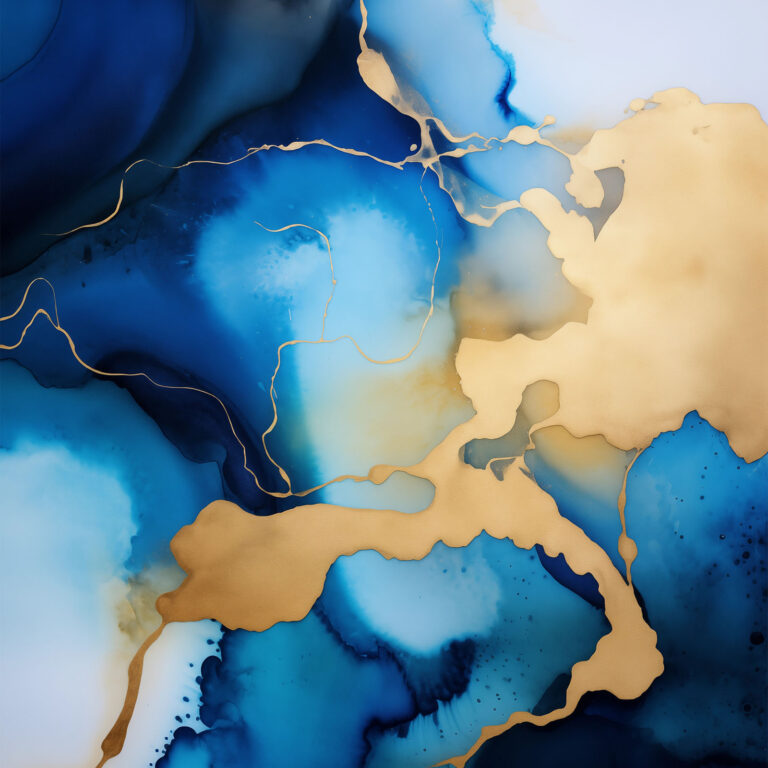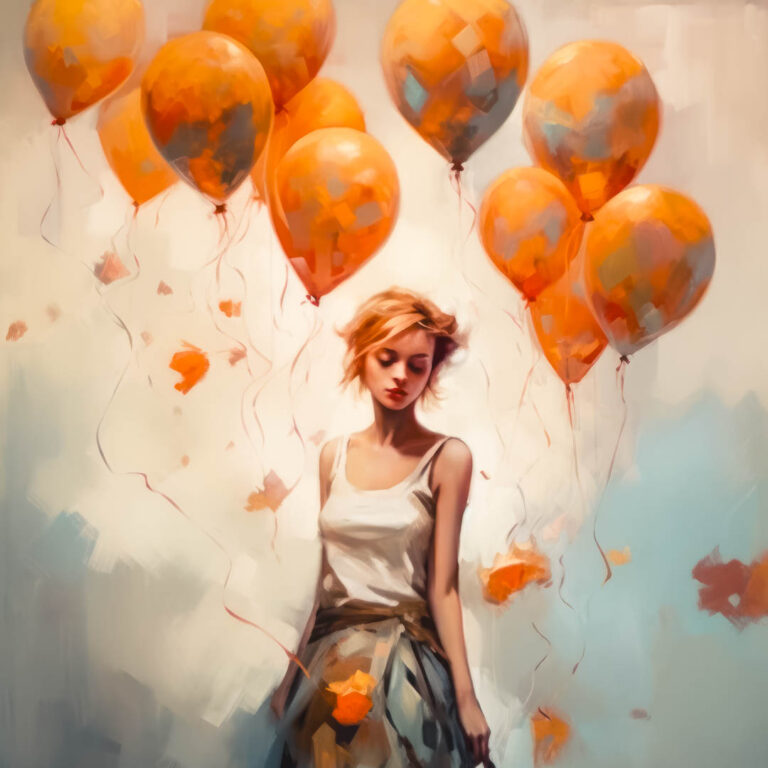Welcome, art enthusiasts and romantics! Today, we’re diving into a world where brushstrokes meet heartbeats and canvas echoes emotion. It’s often said that art and love are two sides of the same coin, both capable of stirring our souls and making the human heart sing in ways words can’t quite capture. Throughout history, artists and thinkers have pondered this deep connection, using their work to explore the intricate dance between these two profound forces. In this post, we’ll celebrate their union through a carefully curated selection of 15 quotes, each a window into the soul of an artist, revealing the timeless rhythm in which the brush and the heart dance together. So let’s embark on this journey, unraveling the tapestry of emotions that art weaves around the heart.
Is art an expression of love?
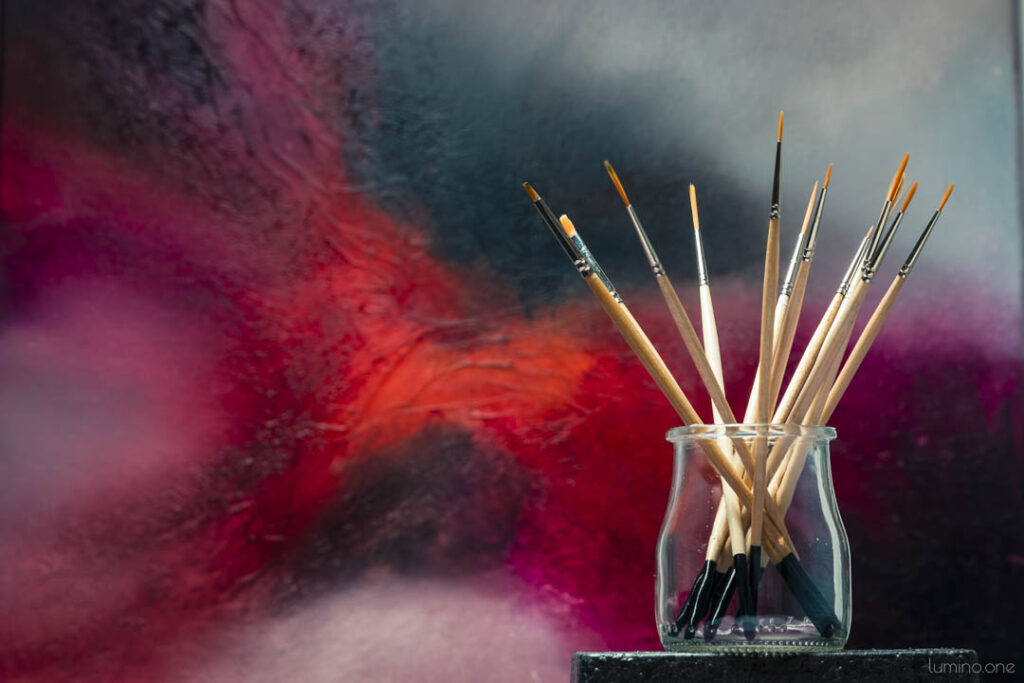
Have you ever stood before a painting and felt a surge of emotion, as if the artist had reached out and touched your very soul? This connection isn’t just happenstance; it’s the essence of what makes us human beings. Art, in its purest form, can be a profound expression of love. It’s not just about the colors on the canvas or the lines on a sketch; it’s about the emotions and experiences that the artist pours into their creation. It’s a love letter, not written with ink, but with passion and sincerity.
When we talk about art, we often focus on the technical aspects – the brushwork, the composition, the play of light and shadow. But, at its core, art is much more than that. It’s a conduit for expressing the inexpressible, for sharing a part of the artist’s soul. And what could be more loving than that? Every stroke, every shade, every texture is a testament to the artist’s desire to communicate, to connect, to share something meaningful with the viewer.
In this way, art becomes a dialogue, a shared experience between the creator and the observer. And isn’t that what love is all about? It’s about reaching out, touching someone’s heart, and in return, finding joy and fulfillment. As viewers, when we resonate with a piece of art, we’re not just admiring its beauty; we’re engaging in a silent conversation with the artist, experiencing a slice of their love and passion. That’s why art can be so moving, so transformative. It’s not just an object to be observed; it’s an experience, a journey of the heart and soul. In that journey, we often derive happiness and a sense of connection that only love can provide.
1. “In our life there is a single color, as on an artist’s palette, which provides the meaning of life and art. It is the color of love.” – Marc Chagall
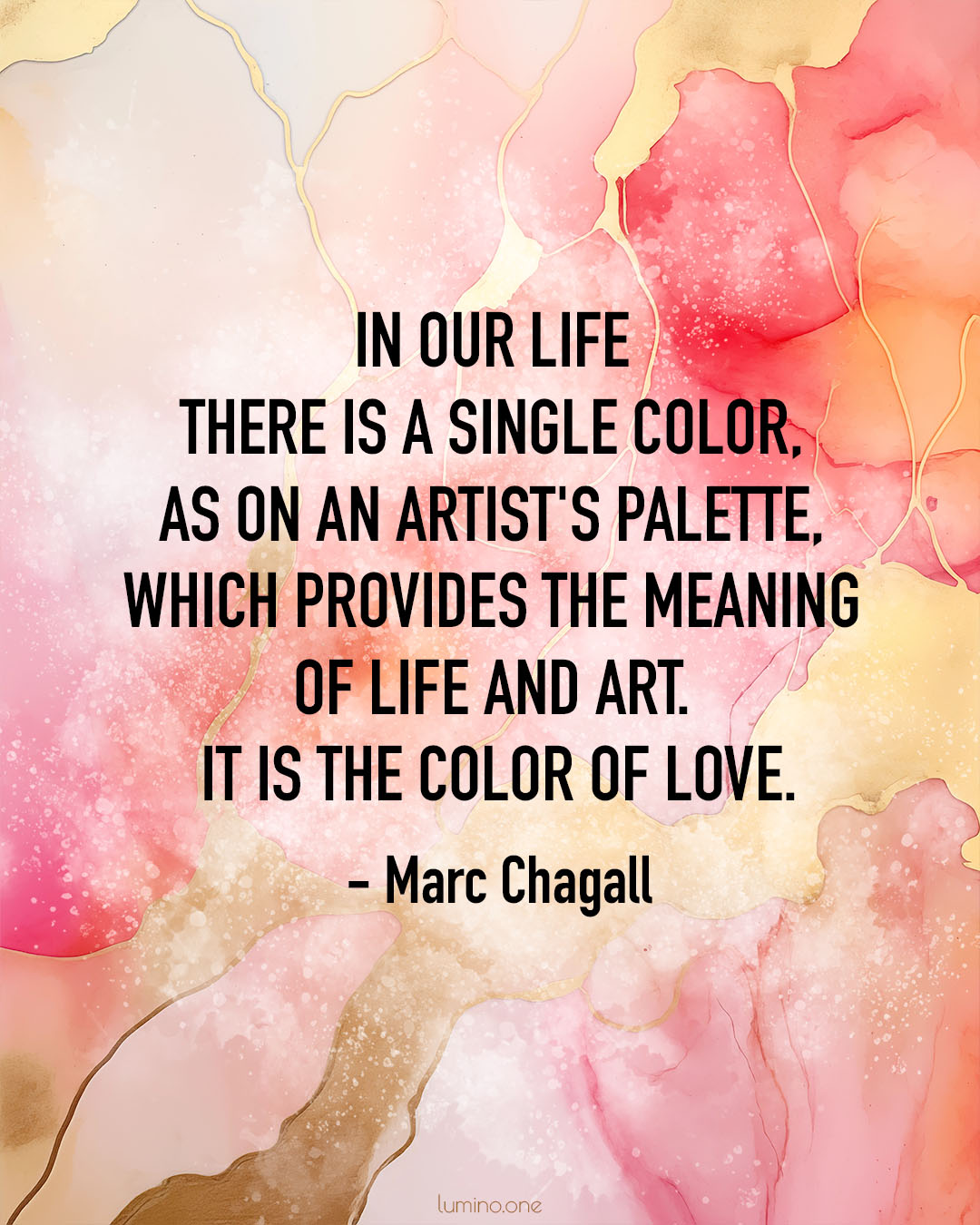
Isn’t it fascinating how a single quote can encapsulate so much? Marc Chagall, with his poetic charm, suggests that love is not just an emotion but a palette from which we paint the canvas of our everyday life. This notion, both simple and profound, resonates deeply with anyone who’s ever held a brush or felt their heart skip a beat. It’s like Chagall is inviting us to view our own reality through a lens tinted with love, a perspective where every moment, every interaction, is an opportunity to create something beautiful.
For a human being, love isn’t just a fleeting feeling; it’s the undercurrent of our existence, a rich pigment that colors every experience. When we apply this to art, it becomes clear why so many masterpieces evoke strong emotions. They’re not just arrangements of shapes and colors; they’re expressions of love – for a person, a place, an idea. This love is what connects the artist to the viewer, bridging gaps across time and space. In Chagall’s words, we find a truth that artists have known for centuries: in the act of creating, in the strokes of a brush or the chisel of a sculptor, there’s an outpouring of love. And it’s this love that infuses art with its power to move and inspire us.
When we reflect on art, it’s essential to remember that it’s more than just a visual experience; it’s a glimpse into the soul of the artist, a peek at how they’ve colored their world with the hues of their emotions. So, the next time you encounter a piece of art, pause for a moment. Think about the love that went into its creation, and how that love, in turn, adds a little more color to the tapestry of your life.
2. “There are always flowers for those who want to see them.” – Henri Matisse

Henri Matisse, a master of color and form, once said, “There are always flowers for those who want to see them.” This simple yet profound statement speaks volumes about the perspective of an artist, and more broadly, about the outlook we, as members of the human race, can choose to adopt. It’s a sentiment that encourages us to find beauty in the mundane, to seek out the extraordinary in the ordinary. Matisse wasn’t just talking about literal flowers; he was urging us to paint dreams on the canvases of our lives, to open our eyes to the beauty that’s all around us.
In a world that often prioritizes practicality and good sense, Matisse’s words are a refreshing reminder of the joy and wonder that can be found when we allow ourselves to look beyond the surface. His philosophy is a testament to the power of art and love in transforming our everyday experiences. When we embrace this mindset, the world becomes a richer place, filled with colors, emotions, and experiences that might otherwise go unnoticed.
The ability to see flowers where others see only the ordinary is what sets the artist apart. It’s a skill that’s not confined to painting or sculpture, but one that permeates all aspects of life. Whether we are artists by profession or just in spirit, adopting this perspective enables us to experience life more fully, more beautifully. Matisse’s quote is an invitation to all of us to view the world through the lens of art and love, and in doing so, enrich our experiences as human beings.
3. “Love is the greatest refreshment in life.” – Pablo Picasso

Pablo Picasso, a name that evokes the very essence of groundbreaking art, once described love as “the greatest refreshment in life.” This statement, coming from a man whose life was as colorful and tumultuous as his art, carries a weight of wisdom and a depth of understanding about the human condition. For Picasso, love wasn’t just an emotion felt between people; it was a driving force in his art, a fundamental part of his creative process. It’s an intriguing idea, isn’t it? That love, in all its forms, could be akin to a refreshment, a vital nourishment that replenishes and revives.
In our personal experience, we often seek refreshment in various forms – a cool drink on a hot day, a moment of respite in a busy schedule. But Picasso challenges us to view love in this same light – as something that rejuvenates and invigorates, especially in the context of making art. It’s a perspective that opens up a myriad of possibilities. When an artist picks up a brush, a writer a pen, or a musician their instrument, is it not a form of expressing love? The love for their craft, for the message they wish to convey, for the audience they aim to reach? This interpretation transforms the act of creation into an act of love, a rejuvenating dialogue between the creator and their medium.
Understanding art as an expression of love offers a refreshing lens through which we can view the works of artists like Picasso. It invites us to delve deeper into the layers of meaning in their creations, to uncover the undercurrents of passion, longing, joy, and even heartache. When we next encounter a piece of art, be it a painting, a sculpture, or a piece of music, let’s pause to consider the love that fueled its creation. In this way, we not only connect more deeply with the art but also with the universal experience of love – a force as potent and revitalizing as Picasso so beautifully articulated.
4. “Art must be an expression of love or it is nothing.” – Marc Chagall

Marc Chagall, an artist known for his vivid use of color and dreamlike imagery, once declared, “Art must be an expression of love or it is nothing.” This powerful statement invites us to ponder the deep connection between the creation of art and the emotion of love. For Chagall, art was not just a means of expression, but a total embrace of life and its many forms of love. Let’s delve into what this means, not just for artists, but for all who encounter art in their daily lives.
In the same way a musician pours emotion into every note, or a writer weaves personal feelings into their narratives, Chagall believed that art is at its most genuine when it’s an outpouring of love. This doesn’t mean that all art must be about love in the traditional sense, but rather that the act of creating art should be driven by a deep passion and connection to the subject. Whether it’s a painting that captures the beauty of nature, or a sculpture that reflects the complexities of human relationships, each piece is a love letter to something or someone.
Chagall’s view challenges us to see art as more than just a visual or auditory experience; it’s an interaction with the heart and soul of the creator. When we engage with a piece of art, we’re not just observing it – we’re connecting with the love that the artist has infused into their work. This perspective enriches our experience of art, allowing us to feel the joy, sorrow, passion, or serenity that inspired the artist. It reminds us that, in its purest form, art is a reflection of the artist’s love for life, nature, and the myriad experiences that shape our existence.
5. “Love is an art, just as living is an art.” – Erich Fromm
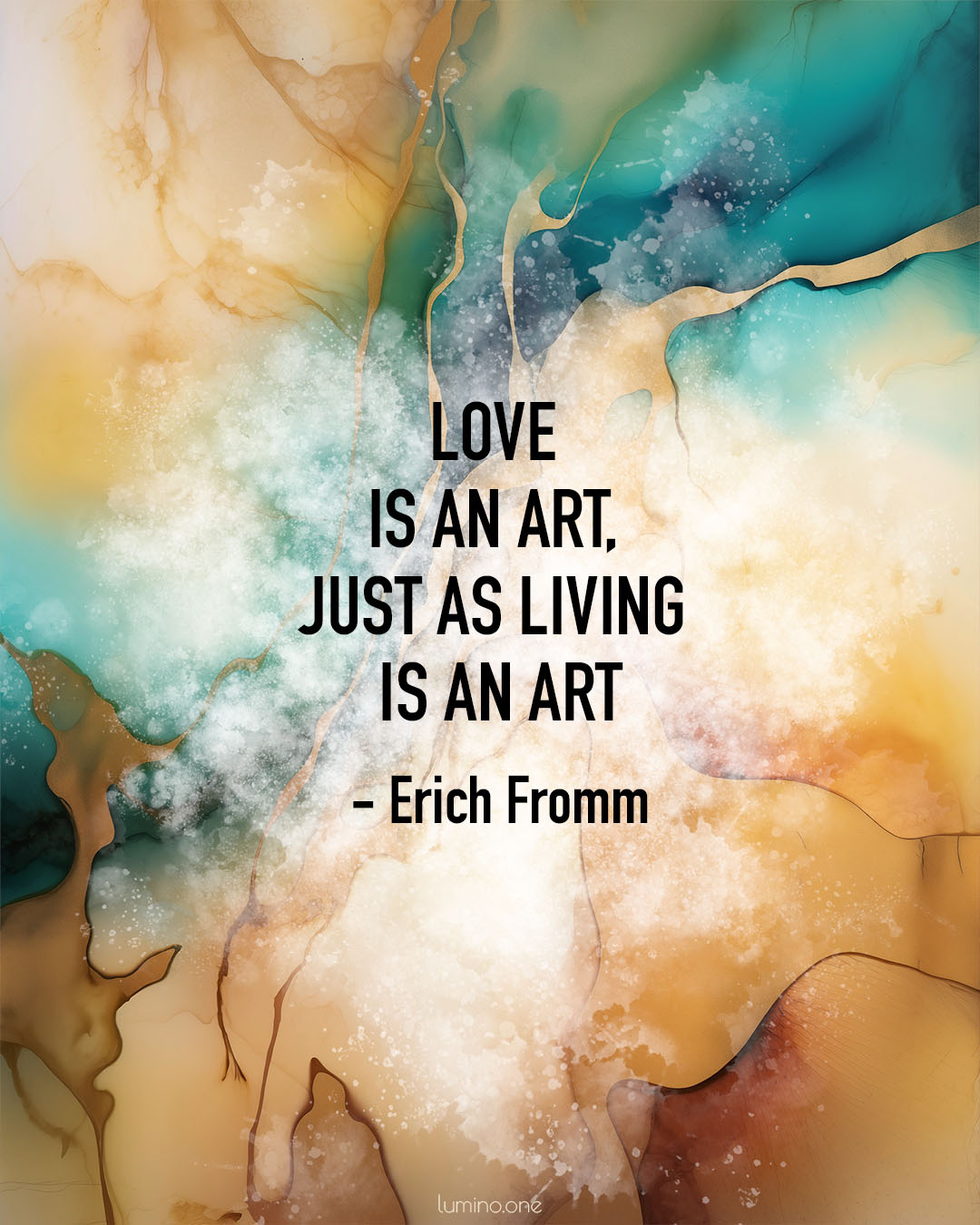
Erich Fromm, a thinker who delved deep into the human psyche, famously said, “Love is an art, just as living is an art.” This statement compels us to view both love and life through an artist’s lens. Like any art form, love requires inspiration and patience. It’s a masterpiece crafted over time, where beauty often lies in the subtleties – a gentle word, a shared laugh, or understanding during tough times. It’s about creating something enduring and meaningful, layer by layer.
Similarly, living as an art form is about the daily choices we make. Each decision paints a stroke on the canvas of our lives. Our interactions, passions, and dreams are expressions of this art. Just like no two paintings are identical, every life is a unique composition of experiences. The art of living is in embracing these moments, adding depth and vibrancy to our personal journey.
Fromm’s insight urges us to see the beauty and creativity inherent in our everyday lives. In love, we find the colors and textures that give depth to our existence. In living, we find the canvas for our personal expression. Both are arts that require practice, patience, and a keen eye for the beauty that surrounds us, reminding us to cherish and cultivate the art in our every moment.
6. “To love beauty is to see light.” – Victor Hugo
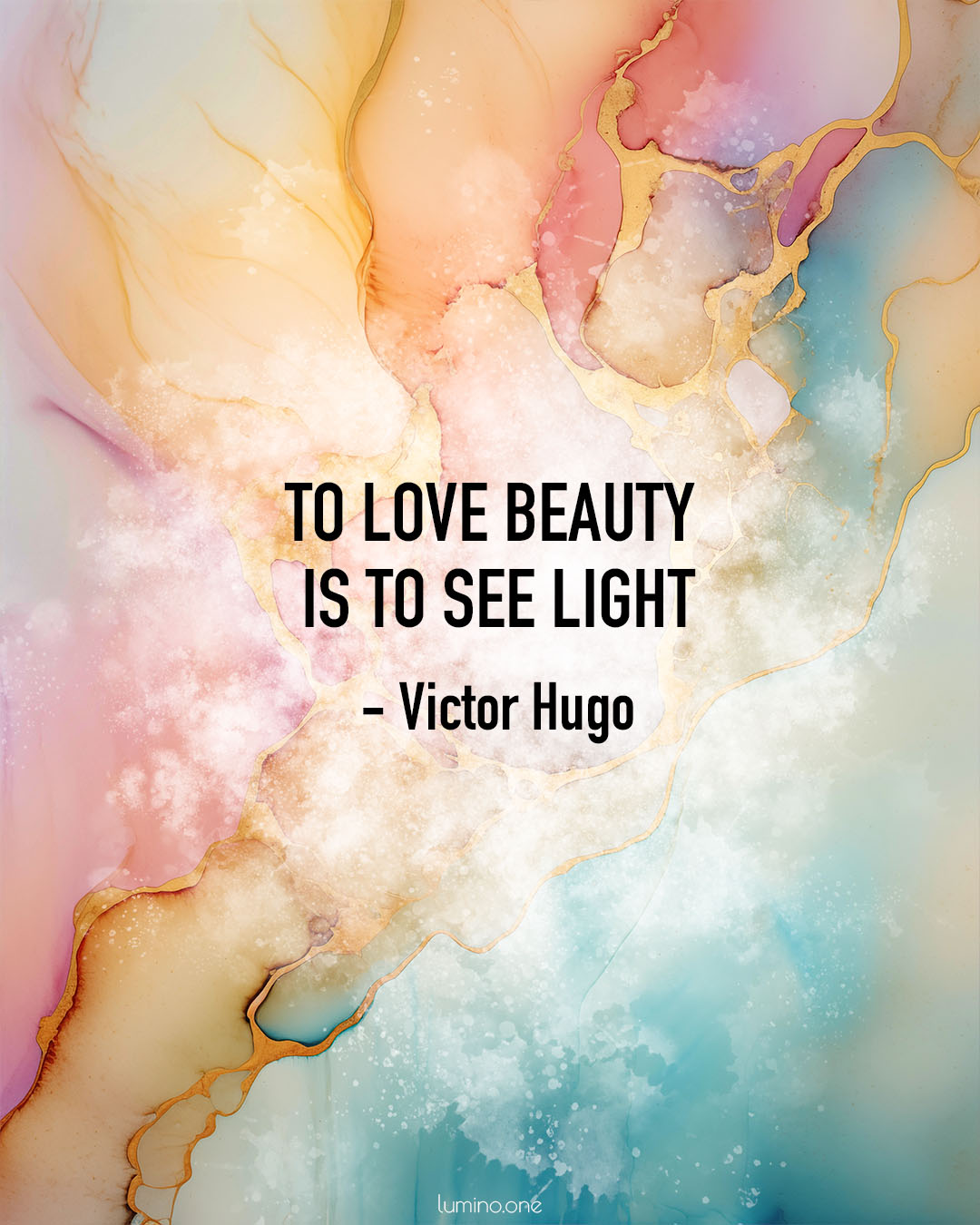
Victor Hugo, a name synonymous with literary grandeur, once stated, “To love beauty is to see light.” This profound observation encapsulates a truth often experienced but rarely articulated with such clarity. When we love beauty – in art, in nature, in human beings – it’s as if a light has been turned on, illuminating aspects of our world and ourselves that were previously in shadow. This idea isn’t just poetic; it’s a powerful lens through which we can view our interactions with art and with each other.
Consider how a picture shows more than just a scene; it reveals a story, an emotion, a piece of the artist’s soul. When we look at a painting and feel moved, it’s not just because of the colors or the composition; it’s because we’ve connected with something deeper, something loved. It’s in these moments that art transcends mere visual appeal and becomes a beacon of light, guiding us to a deeper understanding of beauty and life. Hugo’s words encourage us to actively seek and appreciate this light, to let it illuminate our understanding and heighten our appreciation of the world around us.
There’s also a broader implication here: to love beauty is to nurture hope. In a world often clouded by cynicism and indifference, finding beauty and light is an act of defiance, a statement of faith in the goodness and wonder of life. It’s a reminder that, no matter how dark things might seem, there are always glimmers of beauty waiting to be discovered and cherished. This perspective doesn’t just enrich our experience of art; it transforms our daily existence, turning ordinary moments into extraordinary revelations of light and beauty.
7. “There is nothing more truly artistic than to love people.” – Vincent van Gogh

Vincent van Gogh, a name that evokes intense emotion and vivid brushstrokes, once said, “There is nothing more truly artistic than to love people.” This profound statement by one of the most celebrated artists in history invites us to reflect on the intrinsic relationship between art and love. Van Gogh’s own turbulent life and passionate nature provide a backdrop to understand this concept deeply. To him, art wasn’t just about painting landscapes or portraits; it was about the act of love itself, the pure, unbridled expression of emotion for the subjects he loved.
Art, in its purest form, is an expression of love. Whether it’s love for a person, a moment in time, or the sheer beauty of nature, it’s this emotion that drives an artist to create. When we look at a painting, we’re not just seeing colors on a canvas; we’re witnessing a moment of love captured in time. This is what makes art resonate with us on a deeper level; it’s a shared experience of love, a connection that transcends the physical dimensions of the artwork. Van Gogh’s perspective encourages us to view art not just as a visual experience, but as an emotional journey, a pathway to understanding and feeling love in its many forms.
Understanding love as an art form changes how we interact with the world. It’s about seeing the beauty in everyday moments and appreciating the complexity of the human experience. Just as a painter finds joy in every stroke of the brush, we can find joy in every act of love, big or small. This philosophy can transform our everyday interactions into something more meaningful and profound. In essence, to love is to create art, and to create art is to express love – a concept that Van Gogh, through his tumultuous yet brilliant life, embodied in every sense.
8. “People discuss my art and pretend to understand as if it were necessary to understand, when it’s simply necessary to love.” – Claude Monet
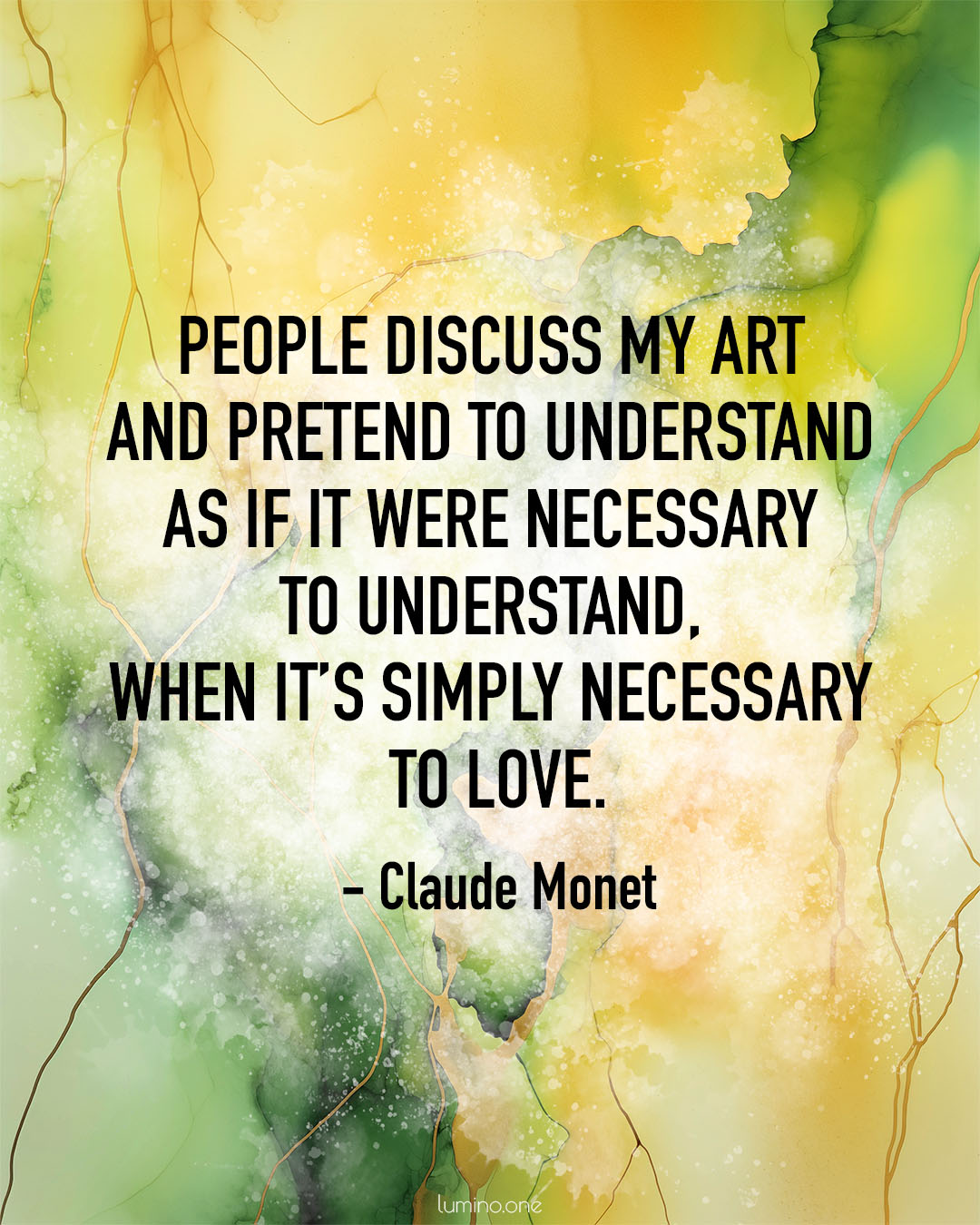
Claude Monet, a master of impressionism, beautifully articulated the essence of art’s impact in this poignant quote. He suggests that the true appreciation of art transcends intellectual analysis, tapping into something more profound, more elemental: love. Monet’s words challenge the conventional approach to art, where understanding is often seen as the key to appreciation. Instead, he invites us to experience art through the lens of our emotions, to connect with it on a level that isn’t bound by the constraints of language or thought.
This approach to art, seeing it through the heart rather than just the mind, opens up a world of experiences. When we engage with art in this way, we allow ourselves to be moved, to feel, to connect in ways that defy explanation. It’s not about dissecting every brushstroke or understanding the historical context of each piece; it’s about letting the art resonate with us on a personal level. Monet’s perspective is a reminder that sometimes the most profound understanding comes from simply allowing ourselves to love – to love the colors, the textures, the emotions that a piece of art evokes in us.
Reflecting on Monet’s insight, we find a deeper appreciation for the arts, recognizing that the value of an artwork isn’t solely in its technical execution or its historical significance. Its true value lies in its ability to touch the heart, to evoke emotion, and to connect with the viewer in an intimate, personal way. Whether you’re an artist, an art enthusiast, or someone just beginning to explore the world of art, remember that your emotional response to a piece is as valid and important as any scholarly analysis. In the end, art, like love, is about feeling, experiencing, and connecting – a truth that Monet captures so eloquently in his words.
9. “Art and love are the same thing: It’s the process of seeing yourself in things that are not you.” – Chuck Klosterman

Chuck Klosterman, with his characteristic insight, equates art and love, suggesting they both involve seeing ourselves in things external to us. This concept, intriguing in its simplicity and complexity, offers a fresh lens through which we can view our interactions with art and our expressions of love. It’s about finding a piece of ourselves in an artist’s palette, in the strokes that speak without words, in the nature that surrounds us – all reflecting parts of who we are or aspire to be.
This process of seeing ourselves in the external world is a fundamental part of being human. When we love someone, we often find echoes of ourselves in them – our joys, our fears, our hopes. Similarly, when we connect with a piece of art, whether it’s a painting, a piece of music, or a beautifully crafted poem, it resonates with us because it mirrors something within our psyche. It could be a shared experience, an emotion, or a dream. Art and love, in this way, become mediums through which we explore and understand ourselves and the world around us. They are the vehicles that drive us to derive happiness and meaning from our experiences.
Klosterman’s comparison invites us to reflect on the nature of our affections and our attractions – to art, to people, to moments. It suggests that our love for these things is not just about them but about what they reveal about us. It’s an ongoing journey of self-discovery and self-expression, where each experience, each relationship, each piece of art adds a new color to the palette of our lives. This realization is enlightening and empowering, providing a deeper appreciation of how art and love intertwine in the tapestry of our existence.
10. “The essence of all art is to have pleasure in giving pleasure.” – Dale Carnegie
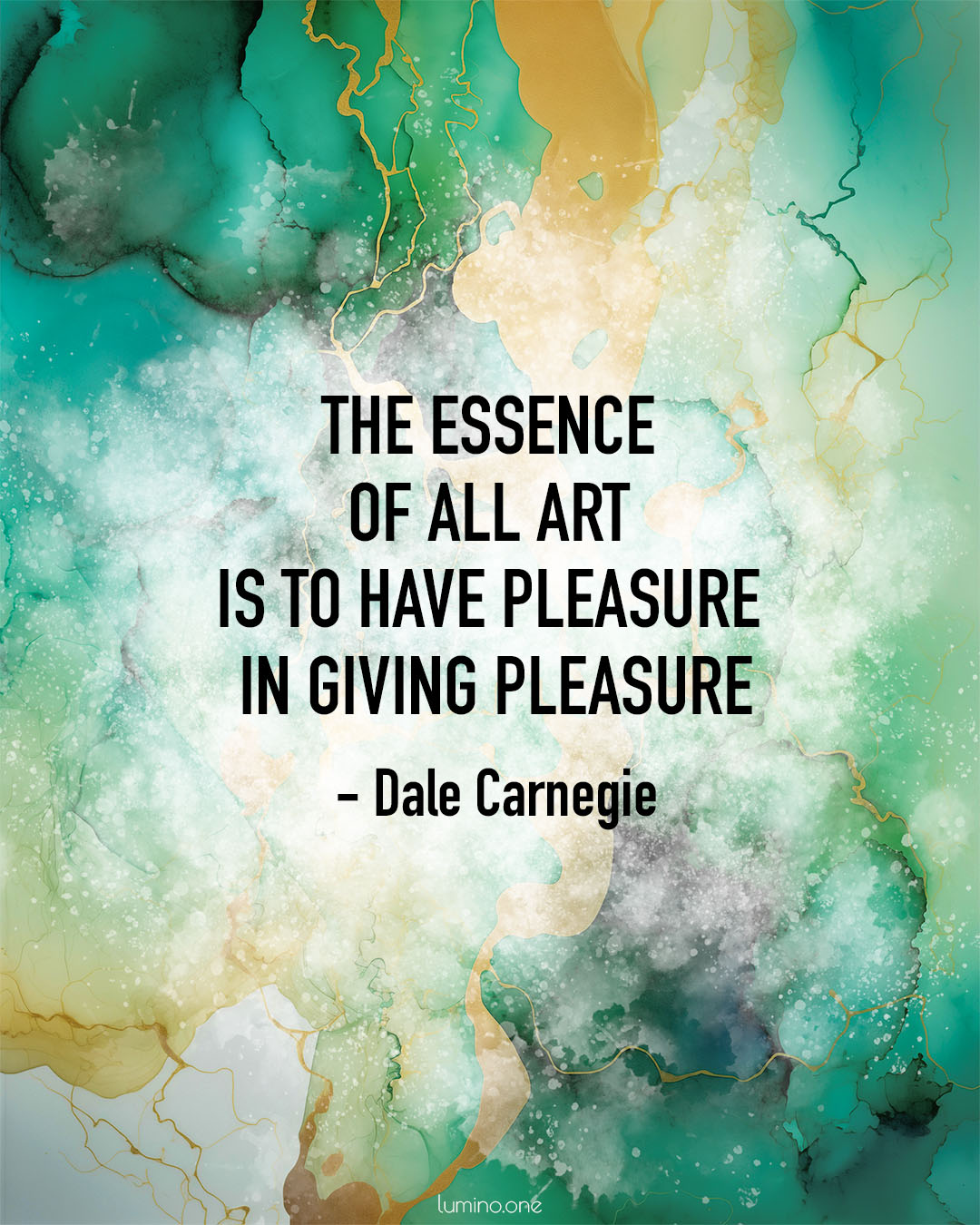
Dale Carnegie, widely known for his insights on human relations and personal development, once captured the spirit of artistry with his words, “The essence of all art is to have pleasure in giving pleasure.” This notion beautifully intertwines the concepts of art and love, suggesting that at the heart of every artistic endeavor is the desire to bring joy to others. It’s a reminder that art, in all its forms, is not just a solitary pursuit but a shared experience, where the artist’s joy in creation becomes the audience’s joy in appreciation.
Delving deeper into this idea, we see how it resonates with the nature of love. Just as an artist finds fulfillment in the act of creating and sharing their work, love too is about the happiness that comes from bringing happiness to someone else. It’s a reciprocal dance of giving and receiving pleasure, where the joy of one becomes the joy of the other. This parallel between art and love highlights the inherent generosity and selflessness that underpin both. Whether it’s a painter in front of a canvas, a musician composing a melody, or a person expressing love, the ultimate aim is to create moments of joy and connection.
Carnegie’s perspective encourages us to approach both art and love with a sense of purpose and a desire to enrich the lives of others. It invites us to see the creation of art and the expression of love as acts of giving, where the true reward lies in seeing the happiness our efforts bring to others. This understanding deepens our appreciation for artists and the art they create, as well as for the people we love and the love we share. It’s a reminder that in both art and love, the greatest pleasure comes from making others happy.
11. “Love of beauty is taste. The creation of beauty is art.” – Ralph Waldo Emerson
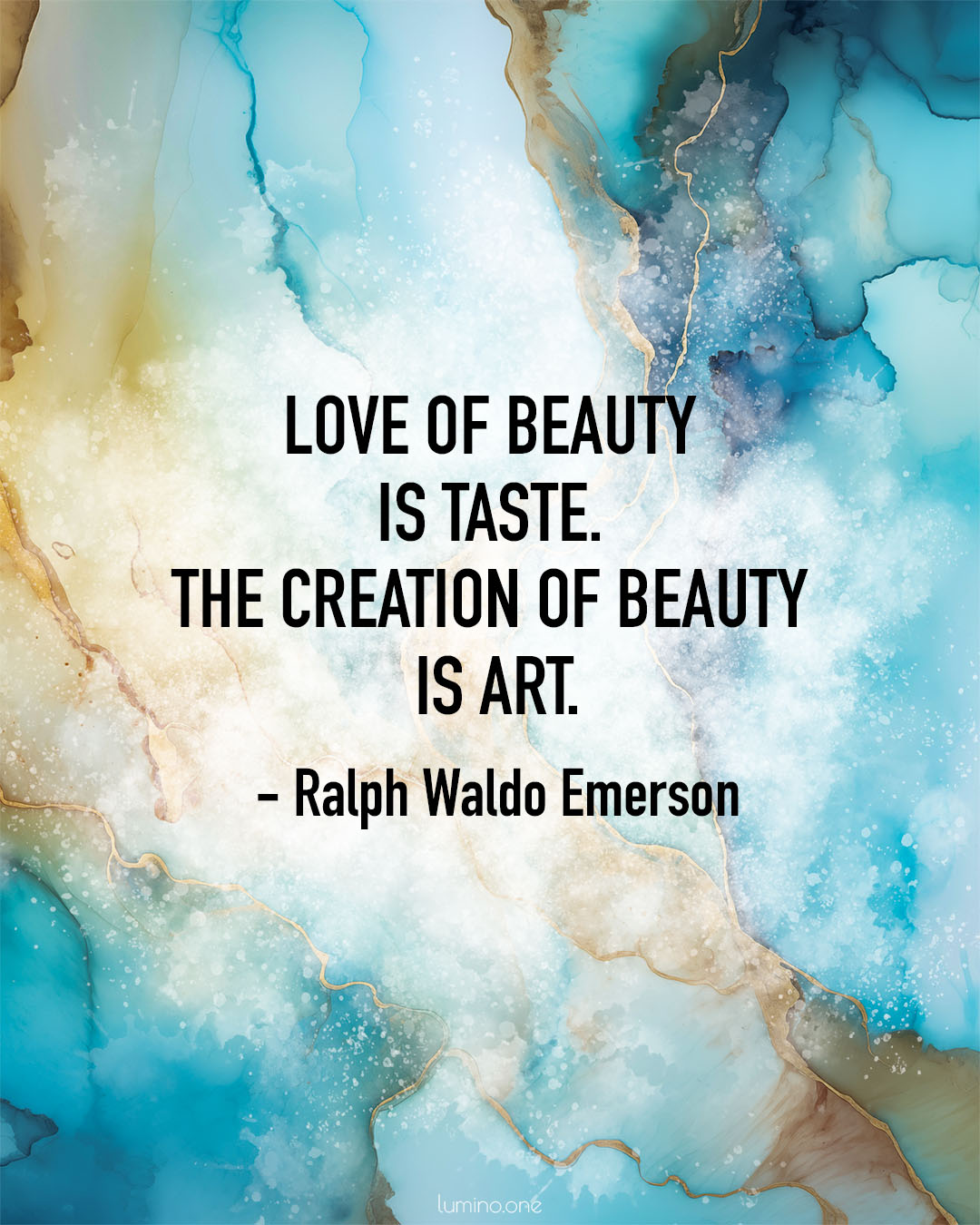
Ralph Waldo Emerson, a sage of transcendentalism, once elegantly stated, “Love of beauty is taste. The creation of beauty is art.” This insightful quote encapsulates a profound truth about the intertwined nature of art, beauty, and love. Emerson suggests that the appreciation of beauty is not just an instinct but a refined taste, a cultivated sensibility that deepens our engagement with the world. It’s a concept that echoes in the halls of art galleries, in the quietude of studios, where artists transform their love for beauty into tangible forms, thereby creating art.
Expanding on Emerson’s thought, it becomes clear that the act of creating beauty is an act of love itself. For an artist, every brushstroke, every chiseled line, every note in a melody is a love affair with beauty. It’s a process steeped in emotion, a pursuit driven by the desire to manifest one’s deepest feelings and thoughts into a form that others can see, hear, and feel. This creation of beauty, therefore, becomes a gift of love to the world – an offering that transcends language and culture, touching the hearts of those who interact with it.
Moreover, this quote prompts us to reflect on our own responses to art. When we stand before a masterpiece, are we not engaging in an act of love? A love for the beauty that stirs our souls, that challenges our perceptions, that comforts our hearts. Emerson’s words encourage us to embrace this love, to allow it to guide our explorations of art and beauty. In doing so, we not only enrich our aesthetic experiences but also connect more deeply with the universal human pursuit of beauty – a pursuit that, at its core, is an expression of love.
12. “Love is the spirit that motivates the artist’s journey.” – Eric Maisel

Eric Maisel, a notable figure in the world of creativity and psychology, once profoundly stated, “Love is the spirit that motivates the artist’s journey.” This insightful observation offers a unique perspective into the heart of artistic creation. It suggests that at the core of every brushstroke, every line in a poem, or every note in a melody, there is an undercurrent of love. This love might be for an idea, a vision, a feeling, or the sheer joy of creation itself. It is this love that fuels the artist’s journey, driving them forward through challenges and inspiring them to bring their inner visions to life.
Exploring Maisel’s thought further, we can see that this love extends beyond the personal realm of the artist. It reaches out to the audience, to the viewer, to the reader, inviting them to share in the artist’s passion. An artist’s work is a gift of love to the world – a way of expressing and sharing their deepest emotions and thoughts. Whether it’s a painting that captures the sublime beauty of nature or a song that articulates the complexities of human emotion, each work of art is a testament to the artist’s love for their craft and their audience.
This concept of love as a motivating force in art also challenges us to reflect on our own responses to art. When we engage with a piece of art, are we not, in a way, engaging with an artist’s love? It’s an invitation to not just observe but to feel, to connect, to understand. Maisel’s words encourage us to view art not just as a product but as a process – a process of love that starts with the artist and continues with every person who interacts with their work. It is a reminder that in the world of art, love is not just an emotion but a powerful force that drives creativity and connects us all.
13. “The main thing is to be moved, to love, to hope, to tremble, to live.” – Auguste Rodin
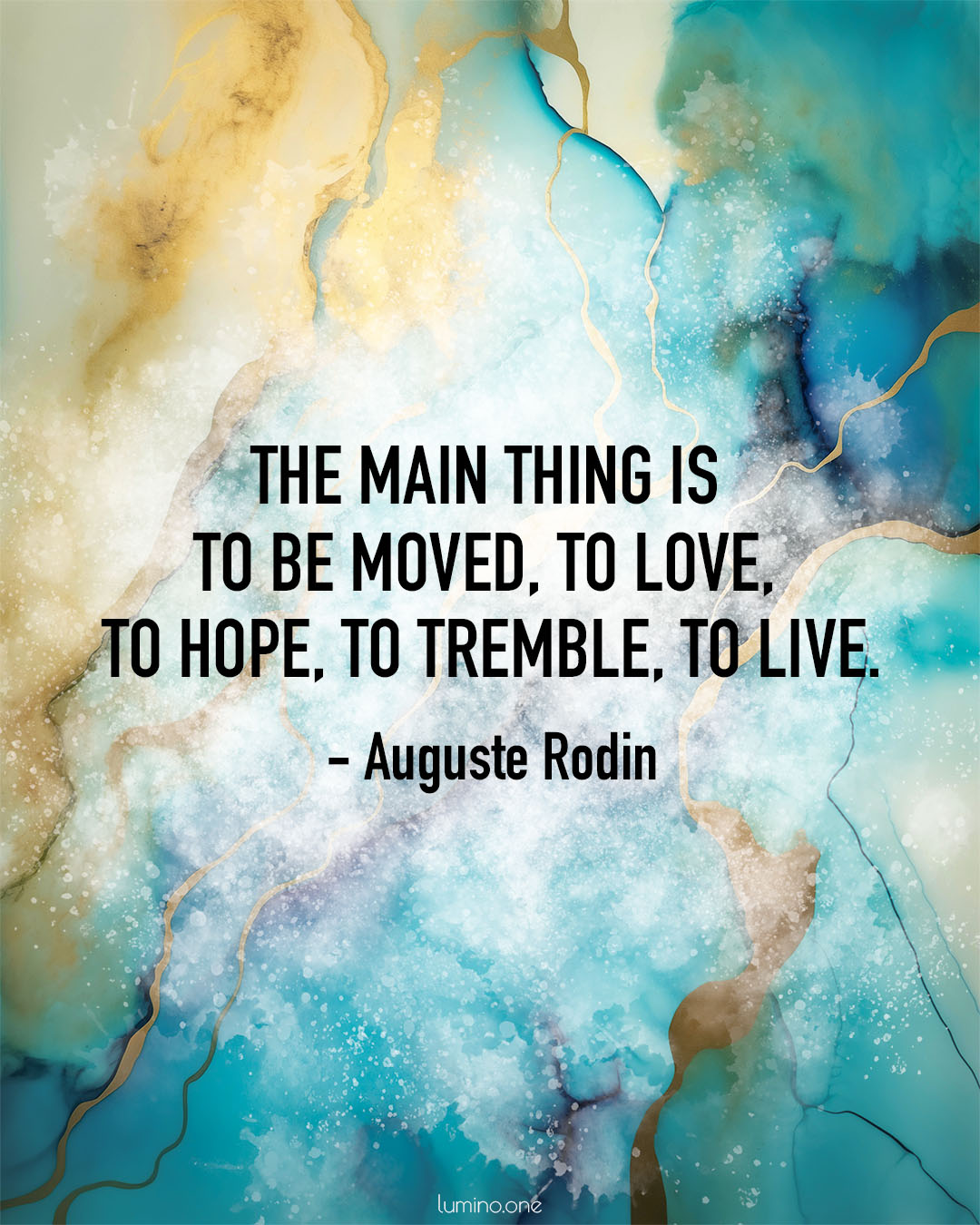
Auguste Rodin, the sculptor whose works speak volumes about the human condition, once encapsulated the essence of both art and life with his words, “The main thing is to be moved, to love, to hope, to tremble, to live.” This quote goes beyond the mere act of creating or observing art; it touches on the core emotions that make us human. Rodin’s perspective invites us to not just appreciate art on a surface level but to engage with it on a deeply emotional plane. It’s about allowing ourselves to be moved by a piece of art, to feel love and hope emanating from it, to experience the trembling excitement of a new discovery, and to feel the fullness of life in each artistic encounter.
Diving deeper, Rodin’s words suggest that the creation of art itself is an act of love, a manifestation of hope, and a testament to the vibrancy of life. Whether it’s a sculpture that captures the intricate subtleties of human expressions or a painting that portrays the raw beauty of nature, each piece is a reflection of the artist’s inner world – their fears, their joys, their hopes, and their love. This emotional investment by the artist is what breathes life into the art, making it something more than just a physical object; it becomes a living entity that speaks, touches, and connects with its audience.
Moreover, Rodin’s quote is a powerful reminder of the role of the audience in the world of art. As viewers, listeners, or readers, our engagement with art is not passive. We are called to love, to hope, to be moved, and to live through our experiences with art. Each piece of art we encounter is an opportunity to reflect on our own emotions and experiences, to connect with something greater than ourselves, and to enrich our lives with the beauty and complexity of human expression. It’s a call to immerse ourselves in the world of art and love, to embrace the full spectrum of emotions it offers, and to truly live through each experience.
14. “Art, like love, moves the heart in unexpected directions.” – Marty Rubin

Marty Rubin, with a keen eye for the subtleties of human experience, beautifully remarked, “Art, like love, moves the heart in unexpected directions.” This quote captures the essence of what makes both art and love so profoundly impactful in our lives. Just as love can take us on unforeseen paths, filled with surprises and discoveries, art too has the power to lead us to uncharted emotional territories. It’s in these unexpected journeys that we often find the most profound insights about ourselves and the world around us.
Consider how a piece of art can evoke feelings we didn’t know we had, or how it can shift our perspective in ways we hadn’t imagined. This is the magic of art – its ability to resonate on a frequency that sometimes even words cannot reach. Love operates in a similar realm, guiding us through a spectrum of emotions, from the dizzying heights of joy to the depths of introspection. Both art and love have this in common: they compel us to grow, to feel, to see things differently, enriching our life experience in the process.
The beauty of Rubin’s observation lies in its simplicity and truth. It reminds us that, in their most authentic forms, both art and love are not static; they are dynamic, ever-evolving forces that have the power to transform. They challenge us, comfort us, and open us up to new possibilities. As we navigate through the myriad of emotions and experiences they bring, we realize that it’s these unexpected turns that make the journey of life so captivating. In embracing the unpredictable nature of art and love, we open our hearts to a world of wonder and endless potential.
15. “In art as in love, instinct is enough.” – Anatole France
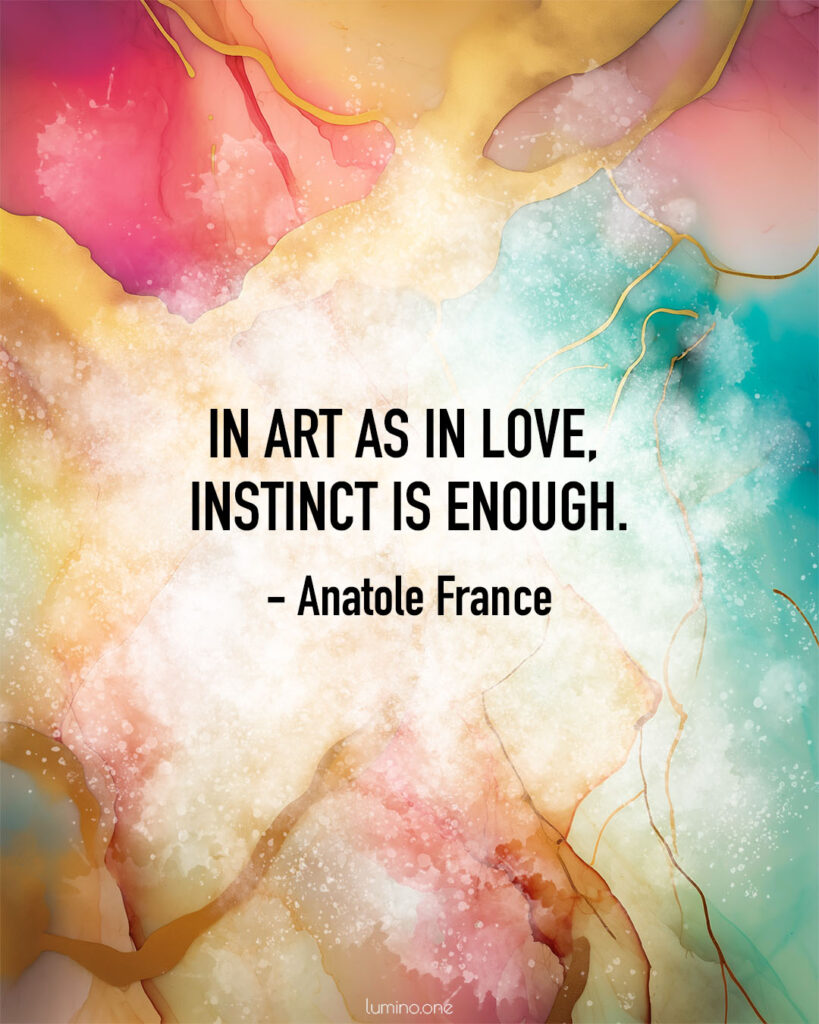
Marty Rubin, an insightful thinker, once noted, “Art, like love, moves the heart in unexpected directions.” This statement, both poetic and profound, sheds light on the enigmatic nature of art and love, and their ability to surprise and transform us. Just as love can suddenly shift our perspectives and alter our life paths, art too has the power to redirect our emotions and thoughts, often in ways we never anticipated. It’s this unpredictable journey that makes both art and love so exhilarating and vital to the human experience.
When we delve into the world of art, we’re embarking on a voyage that’s akin to falling in love. Each piece of art we encounter has the potential to stir something deep within us, to challenge our views, or to offer a new understanding of beauty and truth. This is the essence of art’s power – its capacity to evoke a spectrum of responses, from joy to sorrow, from tranquility to turmoil. It’s a dynamic, ever-evolving dialogue between the creator and the observer, much like the ongoing dance of love between people. In both realms, we find ourselves exploring new emotional landscapes, often finding parts of ourselves we didn’t know existed.
Rubin’s comparison also invites us to reflect on the role of the artist and the lover. Both are navigators of the heart, charting courses through uncharted emotional territories. For the artist, the canvas, the clay, or the instrument becomes a conduit for expressing deep, often inarticulate feelings. For the lover, every gesture, word, and act of kindness is a brushstroke on the canvas of their relationship. In essence, both art and love are about connection – a deep, profound connection that transcends the ordinary and transports us to realms of the extraordinary. It’s in these realms that we find the true magic of being human, the sublime joy of experiencing and sharing love in all its forms.
Conclusion
As we close this chapter on the entwining paths of art and love, it’s clear that these twin forces of human expression are far more intertwined than we often realize. The insights from visionaries like Vincent van Gogh and Erich Fromm, which we’ve explored in this journey, highlight a profound truth: art and love, in their purest forms, are inextricably linked, each feeding and nurturing the other. Discover more on the transformative power of art in our post 10 Inspiring Quotes on Art & Creativity with Life Advise.
Reflecting on these thought-provoking quotes, it becomes evident that love isn’t just an emotion reserved for people; it’s a driving force in the artistic process. This love might manifest as a passion for capturing beauty, a deep connection to a subject, or the joy found in the act of creation itself. As you continue to explore art in all its forms, remember to consider the love that lies at its core. For further reading on this, check out our article, 10 Quotes About Art and Life: Wisdom from the Famous Artists.
In parting, I encourage you to carry with you the understanding that art and love are not mere aspects of life but are foundational to our experience as humans. They shape our perceptions, color our emotions, and guide our journeys. Whether you are an artist, an art enthusiast, or simply someone who appreciates the beauty in the world, the nexus of art and love offers endless avenues for exploration and understanding. Continue your exploration of inspirational art quotes, and keep embracing the myriad ways in which art and love enrich our lives.


